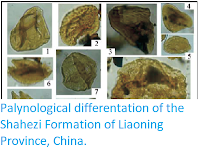Modern Conifers bear their seeds in cones, structure in which the seeds are attached to scales arranged spirally on a central bract. A similar situation is seen in Conifers from Mesozoic and Cainozoic deposits, but the earliest, Carboniferous Conifers, placed in a group called the Voltziales, are somewhat different, with seeds found in the axils of fertile leaf shoots (the angle between the base of the leaf shoot and the stem), which are arranged in a loosely radial pattern on a stem. The first seed cones appear in the Voltziales towards the end of the Early Permian.
In a paper published in the journal PhytoKeys on 25 March 2019, Isabel Van Waveren of the Naturalis Biodiversity Center discusses the peasence of cones in Tobleria bicuspis, a Voltziales Conifer from the Earliest Permian Jambi Palaeoflora of Jambi Province in Sumatra, Indonesia.
The Jambi Palaeoflora comprises a number of coalified plant fossils excavated from outcrops of the Mengkarang Formation along tributaries of the Merangin River. These deposits are thought to be between 296.77 and 296.14 million years old, and were laid down in a tropical forest about 15° north of the Equator. Eighteen samples were used in the study, seventeen of which were collected in 1925 by Wilhelmus Jongmans and Walther Gothan, plus one specimen collected from the same area in 2006.
Map of the Bangko area showing the outcrops of the Mengkarang Formation along the distributaries of the Merangin River where Tobleria bicuspis was found. Van Waveren (2019).
Examination of the samples found that they had cones made up of tightly packed bicuspid (double tipped) scales (typical for cone-bearing members of the Voltziales). The most intact of these (from sample 45311, a slab of light beige, finely banded, tuffaceous mud collected along the Karing River by Jongmans and Gothan) is 24 mm long, and 8-9 mm wide at the base, tapering to about 4-5 mm, although this is not a complete cone, with the base being broken so that it would have originally been somewhat longer.
The three cones from sample 45311: (A) cone C1, (B) Tobleria bicuspis right edge of cone C2 fragment showing bicuspid scale and seeds (C) Tobleria bicuspis cone C3 fragment showing bicuspid scale. Arrows 1–4 in Figure (A) indicate scales in side view, arrow 5 indicates the cone axis. The arrow in Figure (C) indicates a bifid scale. Scale bars: 10 mm (A); 2,5 mm (B); 5 mm (C). Van Waveren (2019).
Each of the scales is about 3 mm wide and 5 mm long, and has two, linked 'fertile utits' (seeds) on its inner surface. These 'fertile units' vary somewhat in shape, from adpressed hemispheres, to heart-shapes attached at the central and narrowest points, to paired almond shapes. These vary in length between 0.6 and 2.6 mm, and in width between 0.4 and 1.6 mm.
Details of dispersed seeds, scales and fertile scales: (A) paired seeds with double wall (sample 45311C) (B) paired seeds with triangular micropylar protrusion (sample 45311 E) (C) detail of triangular micropylar protrusion from paired seeds (sample 45311 E) (D) heart shaped paired seeds/ovules (sample 45311 D) (E) heart shaped paired seeds/ovules (sample 45311 B) (F) juxtaposed almond shaped seeds/ovules (sample 45311 B) (G) bicuspid scale (sample 45311 Aa) (H) bicuspid scale (sample 45311D) (I) bicuspid scale (sample 45471) (J) bicuspid scale with contour of two seeds/ovules (sample 45315) (K) bicuspid scale with darker organic contour of seed (sample 45310) (L) bicuspid scale with heart shaped contour of seeds/ovules (sample 45471). Van Waveren (2019).
Van Waveren notes that four Conifer groups were producing cones by the end of the Permian, the Cordaitanthales, the Ferugliocladales, the Dicranophyllales, and the Voltziales, as well as three non-Conifer groups, the Cycadalean, the Gnetaleans, and the Peltaspermaleans. The first Cycad cones appear in the Early Permian, but are quite distinct from Conifer cones, with their seeds located laterally to (sideways of) their cones, the earliest known Gnetalean cones appear in the Late Permian of China, and are spear-shapes, with single seeds, and the Peltaspermaleans have very rounded scales. The scales and seeds of the Cordaitanthaleans form a distinct wing shape, while the seeds of the Ferugliocladales are attached to the cone axis rather than the scales, while the scales of the Cheirolepidiales are triple in form, but encase a single seed. The cone-bearing Voltziales, in contrast typically have bicuspid cone-scales and double seeds, leading Van Waveren to conclude that the placement of Tobleria bicuspis in this group is quite safe taxonomicaly.
Reconstruction of Tobleria bicuspis. Scale bar is 1 cm. Van Waveren (2019).
See also...
Follow Sciency Thoughts on Facebook.










